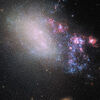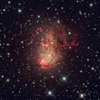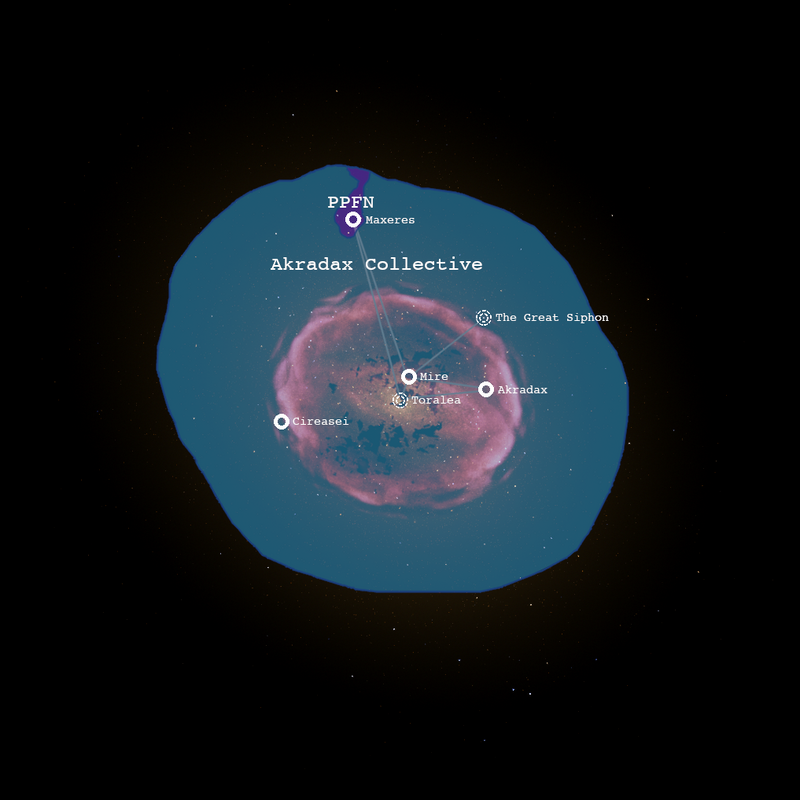What is or is not a satellite galaxy is up for debate. The boundary between a satellite galaxy and an intergalactic overdensity or globular cluster is sometimes unclear. However, there are currently 23 officially recognized satellite galaxies surrounding the Flower Galaxy, at various distances.
Major Satellites[]
Myrmidan Galaxy[]

The Myrmidan Galaxy from the outside.
The Myrmidan galaxy is the closest of the three major Flower Galaxy Satellites. Only containing approximately 700 million stars, Myrmidan only contains seven contacted intelligent species. It orbits at a very close proximity to the Flower Galaxy, and is in a polar orbit around it. Its orbit is slowly degrading, and it will likely soon collide with the galaxy, triggering a wave of star formation.
Currently, the Myrmidan Galaxy is controlled fully (except for a few footholds at the edges) by the reclusive Somnar Hive, a hive-mind empire which the entire UNFG is fighting against to buy time for the last free inhabitants of the galaxy to escape the galaxy.
Lareas Galaxy[]

The Lareas Galaxy from outside its borders, with the endless scars of war hidden from view.
The Lareas Galaxy is the most distant and second largest of the major satellites. The galaxy contains roughly ten billion stars, and interestingly has a higher colonization percentage than Myrmidan, even though it's more distant. It is a very active star former, and it has a large amount of large stars and nebulae. Lareas is currently split in three between the Republic of the Spider Nebula, the Union of Narenna, and the Kormin Empire, and the galaxy is ravaged with a war that has been ongoing for centuries.
The Lareas Galaxy used to be a lot closer in the distant past, and once even brushed past the Flower Galaxy, creating the life-filled Lareas Arm.
Blossom Galaxy[]
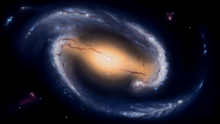
The Blossom Galaxy from intergalactic space.
The Blossom Galaxy is a unique dwarf barred spiral galaxy orbiting the Flower Galaxy relatively distantly and the largest satellite of the Flower Galaxy. Its nations are members of the United Nations of the Flower Galaxy, and are highly militarized to defend against a possible NTIH attack, as any attack from them would have to go through the Blossom Galaxy.
The Blossom Galaxy is relatively sedate in most areas, with most stars being over a billion years old. This leads to a distinct lack of massive stars such as Wolf-Rayets. The galaxy is also of the "Grand Design" subtype, which means that its spiral arms are very well defined and beautiful, with the space between the arms almost as sparse as the halo.
Akradax Galaxy[]
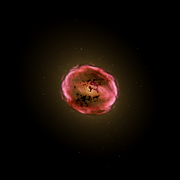
The Akradax Galaxy, with its distinct star-forming region.
The Akradax Galaxy is a medium-sized dwarf elliptical galaxy orbiting the Flower Galaxy. It is almost entirely controlled by the Akradax Collective, which is one of the more reclusive members of the UNFG, aside from a small PPFN colony. The Akradax Galaxy is full of megastructures, due to the Akradax Collective's focus on internal development.
The Akradax Galaxy is also home to the Akradax Molecular Cloud Complex, a large star-forming region surrounding the galactic core. This is unique for dwarf ellipticals, with the only other known structure like this located in the Suvaren Galaxy, almost ten million light-years distant. The nebula is being mined for gases and dust, to conserve resources which would otherwise be spread apart and lost.

The Lance Galaxy, a small elliptical galaxy slowly being torn apart by the Flower Galaxy. The tidal stream of stars and gas is visible here.
Lance Galaxy[]
The Lance Galaxy is a tiny galaxy orbiting very close to the Flower Galaxy's disk. It is being slowly ripped apart by the gravity of its parent galaxy, and is being stretched out into a vast ring. It only has two contacted civilizations, and its outer fringes are colonized by many nations of the UNFG. The Lance Galaxy has almost no young stars, and most of its stars have very low metal content. Because of this, terrestrial planets are relatively rare, which further decreases the likelihood of civilizations developing.
The Lance Galaxy is home to many anomalies, including many dim Aroteon Stars, among other things. Some nations call it the Castrella Galaxy, for some reason. The faint stellar ring caused by the galaxy's stretching out has been colonized by the Kingdom of Saihera, as it passes through its heartlands.
The Lance Galaxy is nominally fully controlled by a native UNFG member nation known as the Encalet Confederacy, but the Confederacy is currently split between the current government and a nationalist anti-UNFG xenophobic group known as the Anti-Xeno Liberation Front, working to violently split the Confederacy away from the UNFG. They currently control roughly half the galaxy from their base at the hidden planet of Parvakel. Diplomatic officers from various other member nations of the UNFG are trying to calm this conflict down, but to no avail.
Morid Galaxy[]

The Morid Galaxy. It's less of a galaxy and more of a loose conglomeration of dim, dying stars and neutral, cold gas.
The Morid Galaxy is a small, dim blob of a galaxy in the outer reaches of the Flower Subgroup. It seems to have no intelligent species, and is littered with massive amounts of ruins, likely from an extinct civilization. The Morid Galaxy consists almost entirely of old, metal-poor stars, and is completely devoid of gas.
It is hypothesized that this extreme lack of gas, unparalleled in anything that isn't a globular cluster, was caused by a massive starburst formation where thousands of very high-mass stars formed at almost exactly the same time, causing the civilization living there at the time, the Moridian High Command, to be rapidly wiped out. The extreme amount of radiation coming from the short-lived stars also sterilized any and all potentially life-giving planets as the lack of gas precluded the formation of any new stars.
Nellai's Object[]
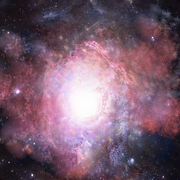
Nellai's Object from the Blossom Galaxy, featuring its densely packed bright stars and nebulae.
Discovered by renowned Carlean astronomer Onir Nellai, Nellai's object is a strange galaxy. It is absolutely miniscule, at just 850 light years across, but it contains around 123 million stars. Nellai's object is also a quasar, emitting high-energy radiation in two opposite directions. It is currently going through an intense starburst spree, forming at a rate of 430 stars every year. Nellai's object is intensely pink, with hints of blue, green and red across its strange filaments of gas, which almost resemble spiral arms. Over a million OB stars, over 30,000 Wolf-Rayet stars and over 1,000 aroteon stars have been documented in Nellai's object, and it is currently the most inhospitable known galaxy in the Flower Galaxy's systems. Fortunately, in around 20 million years, Nellai's object's starburst phase will end, but the "galaxy" will still be extremely dense and quite inhospitable. It is a distant subsatellite of the Blossom Galaxy.
There is only one documented habitable planet in the entire galaxy, located on the edges. Nakuvoas is the only colony in the entire galaxy, a barely habitable icy rogue planet, warmed only by the light of many stars light years away. Work is being done to put Nakuvoas in a stable orbit around a nearby star. Currently it is shared by the entire United Nations of the Flower Galaxy.
Minor Satellites[]
| Image | Name | Stars | Type | Notes | Under Control Of |
|---|---|---|---|---|---|
| Elat Galaxy | 10 million | Irregular | Very distant | ||
| Paloa Galaxy | 5 million | Dwarf Elliptical | Subsatellite of the Lareas Galaxy | ||
| Yuares I | 2 million | Irregular | No one's entirely sure if these two are actually Flower satellites or just free-floating | ||
| Yuares II | 1.5 million | Irregular | |||
| Oria Galaxy | 900,000 | Ultra-diffuse | Extremely sparse, almost half the size of the Flower Galaxy itself but with only 900,000 stars. | ||
| Azertus Galaxy | 750,000 | Irregular | Subsatellites of the Blossom Galaxy. | ||
| Verta Galaxy | 600,000 | Dwarf Elliptical | |||
| Asontes Cloud | 400,000 | Irregular | The only extragalactic colonies of the Cnara-Frealee Federation are located here. | ||
| Trille Dwarf | 350,000 | Irregular | This is a particularly active galaxy, with many stars being formed. Not quite as extreme as Nellai's Object, though. | ||
| Treita I | 250,000 | Dwarf Elliptical | This galaxy is not particularly interesting, but it does have a high concentration of dim Aroteon Stars | ||
| Treita II | 180,000 | Irregular | Treita II contains a thriving interstellar ecosystem, and contains a strangely small number of large planets. | ||
| Treita III | 140,000 | Irregular | Very near Treita II, and is similarly populated by the space creatures. | ||
| Treita IV | 100,000 | Irregular | Smallest nondisputed satellite galaxy. | ||
| Yutze Overdensity | 100,000 | Intergalactic Overdensity | Disputed whether this is a satellite. | - |
Notable Globular Clusters[]
Nalachi Cluster[]
🠊 Main article: Nalachi Cluster
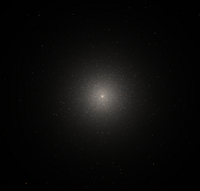
The Nalachi Cluster is a major cluster above the galactic disk of the Flower Galaxy. It is controlled almost entirely by the Pecay-Po Federation of Nalachi, which also controls the sparsely populated galactic halo surrounding it.
Nalachi is an unusually large globular cluster, at 250 light-years in diameter. It is relatively densely packed, making it the largest and brightest globular cluster in the Flower Galaxy's neighborhood. Nalachi's center is occupied by a large black hole unimaginatively known as the Heart of Darkness. The Nalachi Cluster, other than this, contains many ancient artifacts from the ancient Pecay-Po Federation of Nalachi, which is a lot older than it looks.
Exurian Cluster[]
🠊 Main article: Exurian Cluster
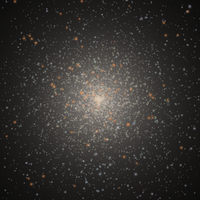
The Exurian Cluster is the largest globular cluster of the Myrmidan Galaxy. It is fully controlled by the Exurian Union, a nation closely allied with the United Nations of the Flower Galaxy, which has sent the vast majority of its military to help in the Ardaya Conflicts.
Exurian is a relatively large globular cluster, that is unusually dense in its inner parts. Because of this, most everyone outside it who discovered it assumed that it was much smaller than it actually is, because of this extreme density gradient. However, the Exurian Union is currently constructing a relatively small Birch Planet out of the inner stars of the cluster, to concentrate its population. The outer stars are being left alone, to serve as a destination for Project Alazar.
Maps[]
Maps of all satellites.








